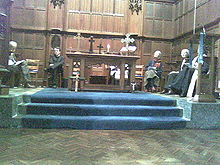- Week of Prayer for Christian Unity
-
The Week of Prayer for Christian Unity is an international Christian ecumenical observance kept annually between 18 January and 25 January. It is actually an octave, that is, an observance lasting eight days.
Contents
Beginnings
The Week of Prayer for began in 1908 as the Octave of Christian Unity, and focused on prayer for church unity. The dates of the week were proposed by Father Paul Wattson, cofounder of the Graymoor Franciscan Friars. He conceived of the week beginning on the Feast of the Confession of Peter, the Protestant variant of the ancient Feast of the Chair of Saint Peter, on 18 January, and concluding with the Feast of the Conversion of Saint Paul on 25 January.[1]
Pope Pius X officially blessed the concept, and Benedict XV "encouraged its observance throughout the entire Roman Catholic Church." For a while, the observance was re-named the "Chair of Unity Octave" by Wattson, in order to emphasize the relationship between Christian unity and the Petrine See (i.e., the papacy).
Protestant leaders in the mid-1920s also proposed an annual octave of prayer for unity amongst Christians, leading up to Pentecost Sunday (the traditional commemoration of the establishment of the Church).[2]
Evolution
Abbé Paul Couturier of Lyons, France, who has been called "the father of spiritual ecumenism",[3] had a slightly different approach than that of Father Wattson, a convert to Roman Catholicism from Anglicanism. He advocated prayer "for the unity of the Church as Christ wills it, and in accordance with the means he wills", thereby enabling other Christians with differing views of the Petrine ministry to join in the prayer. In 1935, he proposed naming the observance "Universal Week of Prayer for Christian Unity", a proposal accepted by the Catholic Church in 1966. Father Couturier's message influenced a Sardinian nun, Blessed Sister Maria Gabriella of Unity, whose deep, prayerful, sacrificial devotion to the cause of unity is held up by Rome as an example to be followed.[4]
In 1941, the Faith and Order Conference changed the date for observing the week of unity prayer to that observed by Catholics. In 1948, with the founding of the World Council of Churches, the Week of Prayer for Christian Unity became increasingly recognised by different churches throughout the world.
In 1958, the French Catholic group Unité Chrétienne and the Faith and Order Commission of the World Council of Churches (a body which includes, among others, most of the world's Orthodox churches as well as many Anglican, Baptist, Lutheran, Methodist, Reformed, United and Independent churches) begin co-operative preparation of materials for the Week of Prayer. The year 1968 saw the first official use of materials prepared jointly by the Faith and Order Commission and the Pontifical Council for Promoting Christian Unity, representing the entire Roman church. Collaboration and cooperation between these two organizations has increased steadily since, resulting recently in joint publications in the same format.
Current observation
In the Southern Hemisphere, where January is a vacation time, churches often find other days to celebrate the week of prayer, for example around Pentecost (as originally suggested by the Faith and Order movement in 1926,[5] and Pope Leo XIII in 1894),[2] which is also a symbolic date for the unity of the church.
The 2008 Week of Prayer for Christian Unity was celebrated as the centennial. For the 2009 Week, the biblical text Ezekiel 37:15–19, 22–24a was chosen.[6] In 2010, the biblical text Luke 24:48 was chosen, with the theme "You Are Witnesses of These Things".[7]
See also
External links
- World Council of Churches: Week of Prayer for Christian Unity
- Pontifical Council for Promoting Christian Unity: Week of Prayer for Christian Unity
References
- ^ Exciting holiness: collects and readings for the festivals by B. Tristam ISBN 1853114790 Canterbury Press 2003 pages 54-55
- ^ a b Resources for 2008 Week of Prayer for Christian Unity
- ^ Ecumenical Meeting with Pope Benedict XVI, World Youth Day 2005
- ^ Homily of Benedict XVI, 25 January 2008
- ^ Faith and Order Commission, World Council of Churches
- ^ Week of Prayer for Christian Unity
- ^ Faith and Order Commission, World Council of Churches
Categories:- Christian ecumenism
- Catholic ecumenical and interfaith relations
- Christian festivals and holy days
- January observances
Wikimedia Foundation. 2010.

